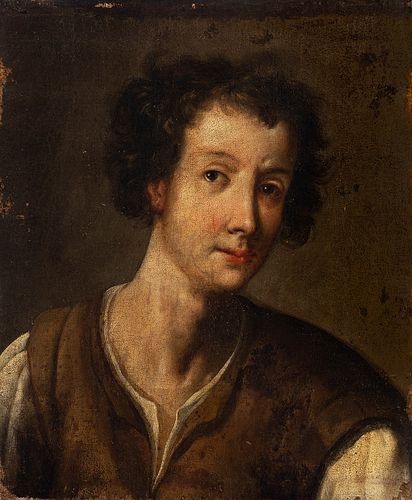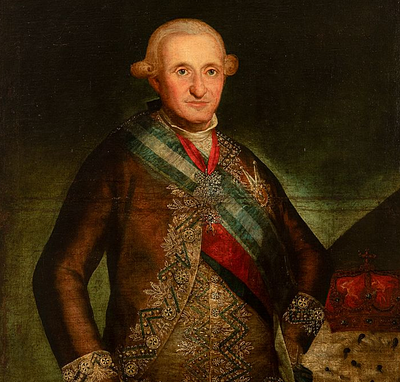Spanish school; last quarter of the 17th century. "Young man". Oil on canvas. Relined
Lot 36
About Seller
Setdart Auction House
Carrer Aragó 346
Barcelona
Spain
Setdart Subastas was born in 2004 and is currently the first online art auction in Spain with solidity, prestige and reliability guaranteed by our more than 60,000 users. Setdart has a young, dynamic and enterprising team ready to successfully manage the purchase and sale of art works through custom...Read more
Estimate:
EUR€4,000 - EUR€5,000
$4,166.67 - $5,208.33
Absentee vs Live bid
Two ways to bid:
- Leave a max absentee bid and the platform will bid on your behalf up to your maximum bid during the live auction.
- Bid live during the auction and your bids will be submitted real-time to the auctioneer.
Bid Increments
| Price | Bid Increment |
|---|---|
| EUR€0 | EUR€10 |
| EUR€200 | EUR€25 |
| EUR€500 | EUR€50 |
| EUR€1,000 | EUR€100 |
| EUR€3,000 | EUR€200 |
| EUR€5,000 | EUR€500 |
| EUR€10,000 | EUR€1,000 |
| EUR€20,000 | EUR€2,000 |
| EUR€50,000 | EUR€5,000 |
About Auction
By Setdart Auction House
Sep 22, 2021
Set Reminder
2021-09-22 09:30:00
2021-09-22 09:30:00
America/New_York
Bidsquare
Bidsquare : 22nd September - ARAS JÁUREGUI Private Collection - Old Masters, 19th & 20th Century
https://www.bidsquare.com/auctions/setdart-auction-house/22nd-september---aras-j-uregui-private-collection---old-masters-19th-20th-century-7427
ARAS JÁUREGUI Private Collection - Old Masters, 19th & 20th Century Setdart Auction House sofia@setdart.com
ARAS JÁUREGUI Private Collection - Old Masters, 19th & 20th Century Setdart Auction House sofia@setdart.com
- Lot Description
Spanish school; last quarter of the 17th century. "Young man". Oil on canvas. Relined It presents lack of stretcher, damages and repainting. Measurements: 56 x 47 cm. The curly and dark hair frames a masculine face of youthful character, of which the dark eyes stand out, which stand out on the light skin of the young man. The eyes have a look of a certain sadness or melancholy. The precision of the drawing, which stands out in details such as the nose and the mouth with pink lips, harmonise with the protagonist's gaze, resulting in a portrait of a psychological nature in which the sitter is presented to the viewer as a young man who has not yet completed his maturity, but is just beginning to do so. The expressiveness of the work, which is defined by the use of an immediate brushstroke that is blurred at certain moments, shows us the aesthetic heritage of both Bayeu and Goya. In its aesthetic, the work is close to some of the portraits painted by Manuel Francisco Bayeu, who began his training in his native Saragossa, attending the workshop of Juan Andrés Merklein, a painter of Bohemian origin, and the drawing classes of José Luzán Martínez. In 1756 he was awarded the Extraordinary Prize at the San Fernando Academy, which earned him a scholarship in 1758 to study for two years at the San Fernando Academy in Madrid. However, Bayeu left the academy only two months later because of his disagreements with one of the professors, Antonio González Velázquez. He then returned to Saragossa and his financial situation became complicated, as the death of his parents forced him to take charge of his family. He then began his career as a painter, carrying out commissions for churches and convents in the city. Around this time, in 1759, he married Sebastiana Merklein, the daughter of his master. During these years he developed the language of his youth, influenced by Lucas Jordán and Corrado Giaquinto. However, in 1762 Anton Raphael Mengs, the leading court painter, visited Saragossa and asked him to work with him on the decoration of the new Royal Palace. Thanks to Mengs's protection, Bayeu carried out various decorative commissions for the Royal Sites, thus establishing himself as one of the most outstanding painters of the day. These early works for the court included the fresco decoration of the vaults of the dining room in the queen's bedroom ("The Surrender of Granada") and the antechamber of the Princes of Asturias ("The Fall of the Giants"). His Baroque training is still evident in these works, but elements of his mature language can already be glimpsed, such as the elegance of the positions, the meticulousness, the neoclassical lighting effects and the perfect anatomical study. By the 1760s his neoclassical aesthetic was fully formed, marked by a clean, precise drawing and a palette that played with the contrast of reds and yellows over a tonality based on blues and greys, as can be seen in "Hercules on Olympus" (conversation room of the Princes of Asturias in the Royal Palace), "Apollo remunerating the Arts" (El Pardo) or "Providence presiding over the virtues and faculties of man" (room next to the gala dining room of the Royal Palace). Within his religious production of these years, the eleven fresco scenes illustrating the lives and miracles of Toledo saints in Toledo cathedral, works that were already completely indebted to Mengs, are particularly noteworthy. After the latter's departure for Rome in 1777, the Aragonese painter took on all the duties left by Mengs as his first painter, although he did not obtain this appointment. These tasks included designing cartoons for the Royal Tapestry Factory, where he supervised the work of Goya, his brother-in-law from 1773. In 1785 he was commissioned by Charles III to restore the paintings in the royal collections.
- Shipping Info
-
In-house shipping available. Please inquire at admin@setdart.com.
-
- Buyer's Premium



 EUR
EUR CAD
CAD AUD
AUD GBP
GBP MXN
MXN HKD
HKD CNY
CNY MYR
MYR SEK
SEK SGD
SGD CHF
CHF THB
THB
















